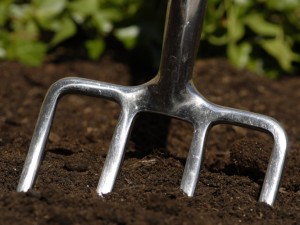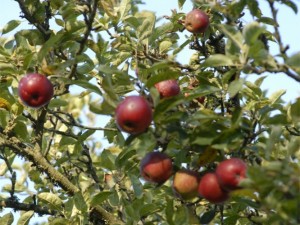Growing fruit
Growing fruit often comes second place to growing vegetables, in many gardens, why? – well I think a lot of people feel that growing fruit may be tricky, or that crops can often be disappointing in relation to the outlay and effort put into cultivation. In response to this, I would say that in recent years, suppliers have done a lot to produce what are effectively “easy grow” options, and never before has so much advice been available, whether in books or free online. Therefore, if you’ve tried and failed in the past, it is well worth trying again! On this site I have a number of specific growing guides, but below are a few general pointers about growing fruit in your garden.
Fruit gardening considerations
-

Digging in plenty of compost and well-rotted garden manure will always improve fruit tree/plant growth and yields.
Plan a fruit garden carefully as planting trees and bushes can be costly and time-consuming. Careful planning for positioning will ensure the best results for minimum effort.
- Good drainage is important as fruit plants will not survive with waterlogged roots. Dig in plenty of sand and grit and consider raised beds.
- Thick mulch is essential as fruit plants are shallow rooted and mustn’t be allowed to dry out. Mulching will also suppress weeds.
- The soil at the base of walls and fences is almost always quite dry. Until fruit trees have been able to establish strong roots, they will need a considerable amount of water. In fact, generous watering fro the first year after planting is crucial.
- Good planting will determine the future health and productivity of a plant. Dig a big hole, mix garden compost with the soil and plant at the same depth as plants are grown in their pots. Gently pack the soil around the roots, filling and firming as you go. Don’t allow weeds and grass to grow within a circle around the plant, as wide as the plant is high, for three years.
Growing fruit in small gardens
-

You don’t need full sized fruit trees for a good crop. Look at the dwarf options available if you have a small garden!
The benefits of planting trees and the nutritional value of fruit has indeed reawakened an interest in fruit gardening, but people still believe that they do not have enough space to grow fruit in their garden. However, with modern stock and training, this is not a problem. It is possible to include fruit, even in the smallest gardens by making use of dwarf stock and single-stem cordons.
- To create cordons, when a young tree is growing, remove sideshoots, and train to grow as a single, rope-like stem.
- The smallest garden, patio or balcony can produce enough apples, pears, plums or cherries for the average family. An increasing variety of small trees are grown on dwarfing root stock so that pruning and picking are easy too. Miniature or dwarf fruit trees will produce regular-sized fruit on smaller trees. Be sure to check out what your local garden centre supplies in this area.
- Fences and walls can be put to good use for growing fruit in a small garden. There are fruit varieties for every aspect, from full sun to full shade. Cleverly used, walls and fences can extend the fresh fruit season. Sunny walls make it possible for plants to crop much earlier than is possible in the open, and shady walls extend the season after the normal crop has been gathered in.
Please take a look at the ‘Related Posts’ further down this page for more information on general planting techniques, and instructions on growing specific fruits.
